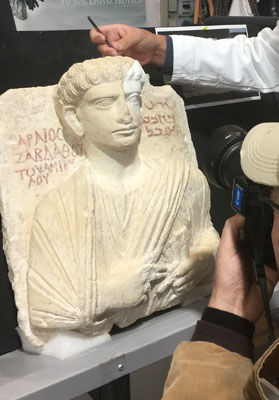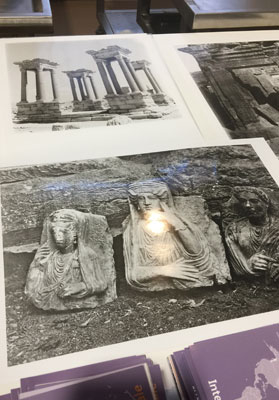Two damaged sculptural busts from Palmyra, dating to the 2nd or 3rd century AD, were sent home from Rome to Syria on Monday 27 February. After being treated in Italy, the busts were returned to the National Museum of Damascus, accompanied by two representatives of the Syrian Directorate-General of Antiquities and Museums (DGAM).
New technologies, including laser scans and 3D printing, played a key role in the reconstruction of these sculptures.
ICCROM’s Director-General, Stefano De Caro, commented: “This restoration and partial reconstruction of ancient objects is a striking case – it made use of fills in modern materials, while ensuring these were reversible. Even if on a small scale, this is an innovative example of how to address severely damaged antiquities.”
The busts, called the “war-wounded of Palmyra” by former Rome mayor Francesco Rutelli, had been badly smashed with hammers by insurgents. Rutelli arranged for the busts’ arrival in Italy and their subsequent restoration through his association entitled Incontro di Civiltà (Encounter of Civilizations), negotiating the objects’ transfer through contacts with the Syrian DGAM and members of the opposition. The two busts were featured in a UNESCO-sponsored exhibit called “Rising from Destruction” curated by Rutelli and held at the Colosseum in Rome through 16 December 2016.
With the support of Italian Culture Minister Dario Franceschini, the busts were entrusted to the Italian ISCR (Istituto Superiore per la Conservazione ed il Restauro, or Higher Institute for Conservation and Restoration). A team of restorers led by ISCR Director Gisela Capponi stabilized the sculptures, then reconstructed and replaced the destroyed parts of the busts according to strict restoration criteria. The restored busts were revealed at a press conference at ISCR on 16 February 2017.
The busts depict a man and woman, most likely elite Palmyrans. The inscriptions on the busts are in Aramaic and Greek.
As the male bust was severely damaged, the restoration team devised a reconstruction method. They 3D-scanned the remaining facial features on the right side of the bust, mirroring them to the left. The flipped scans were used to devise a fill or prosthesis for the missing parts, which was then 3D-printed using nylon powder. The fill is held in place with magnets and can be removed at any time, thus respecting the reversibility principle.
Capponi noted during the press conference at ISCR, “The restoration set out to erase this brutal act, while leaving the additions recognizable.” She continued, “It was a great honour for us to be able to restore such extraordinary artefacts, which were so brutally damaged.”
Restorer Antonio Iaccarino Idelson said that the intervention was unlike those undertaken by the ISCR in the past. He noted the Syrian request to remove all trace of damage, and to restore the objects to their original state. The team used the 3D scanning technique to ensure authenticity through mathematical symmetry, reducing the role of human judgement. However, the restorers needed to adjust for small anatomical anomalies – one ear higher than the other, for example. The ISCR team also allowed for a skin-like overlay on top of the 3D print fill, using stone dust. In this way, with more conventional restoration techniques, they crafted a surface layer compatible with the sculptures’ own marble surface.
De Caro stated, “This careful solution demonstrates a deep respect for restoration principles. These are the qualities advocated by ICCROM to solve the restoration problems of Palmyra – employing modern methods and materials to give an idea of what was, in ways that respect reversibility while ensuring that appropriate research has been done.”
De Caro further mentioned the role played by international collaboration and cultural diplomacy. “Despite ongoing sanctions and war, a way was found to permit the restoration of these damaged antiquities.”
Franceschini also noted the role of cultural diplomacy. “This is an example of an issue we hold dear: that of cultural diplomacy, the fact that culture can be an instrument for dialogue between people, even when circumstances are difficult.”
Rutelli emphasized at the conference, “We do not accept the last word is given to terrorists. If they want to destroy, there will always be somebody able to rebuild.”
In a tweet dated 9 February, Rutelli had declared, “Italy restores what terrorists destroy.”
The restoration of these antiquities was dedicated to the late head of antiquities at Palmyra, Khaled al Assad, executed by insurgents in August 2015.
The return of the busts to Syria coincided with news of Palmyra’s return to Syrian government control on 2 March. This ends the second occupation of Palmyra by insurgent forces.
Maamoun Abdulkarim, Director-General of Antiquities and Museums of Syria, told CNN, “Our work in Syria as archaeologists is scientific and not political, because the war in Syria will finish and the politics will change, but the heritage must remain as a memory of all Syrian people. This is a project of peace.”


